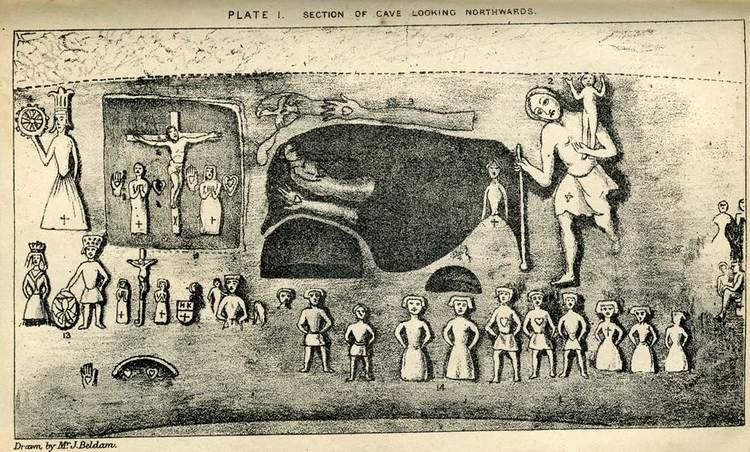Phone +44 1763 245484 | ||
 | ||
Similar Scott's Grotto, Hilfield Castle, St Mary the Virgin's Church - L, Cheshunt Great House, Church of St Nicholas | ||
Royston cave a medieval enigma
Royston Cave is a small artificial cave located in Katherine's Yard, Melbourn Street, Royston, England. It is located beneath the crossroads formed by Ermine Street and the Icknield Way. It is protected as both a scheduled ancient monument and Grade I listed building. It has been speculated that it was used by the Knights Templar, who founded nearby Baldock, but this is unlikely, despite its enormous popular appeal. There are numerous theories about the Cave covering Freemasons and Templars as well as possibilities that the Cave was a prison or an anchorite cell. However, none of these theories have enough hard evidence to warrant their being adopted by the Cave Trust. It is open to the public in the summer months on Saturday, Sunday and Bank Holiday afternoons between Easter and October.
Contents
- Royston cave a medieval enigma
- royston cave grapevine of the knights templar
- Speculations
- Rediscovery
- Restoration
- References
Royston Cave is a circular, bell-shaped chamber cut into the chalk bedrock. It is 8 metres (26 feet) high and 5 metres (17 feet) in diameter with a circumferential octagonal podium. The origin of this chamber is unknown. This cave is unique in Britain - if not the world - for its numerous medieval carvings on the walls; comparable examples exist only in the former Czechoslovakia and the former Palestine. Some of the figures are thought to be those of St. Catherine of Alexandria, St. Lawrence and St. Christopher.
royston cave grapevine of the knights templar
Speculations
Royston Cave has been the source of much speculation, although it is hard to determine much about its origin and function.
Rediscovery
Although the origin of the cave is unknown, the story of the rediscovery is very well known. In August 1742 a workman dug a hole in the Butter Market to build footings for a new bench for the patrons and traders. He discovered a buried millstone and dug around it to remove it. He found a shaft leading down into the chalk.
When discovered, the cavity was more than half-filled with earth. The rumour was that there must be a treasure buried beneath the soil inside the cave. Several cartloads of soil were removed until bedrock was reached. The soil was discarded as worthless as it only contained a few old bones and fragments of pottery. Today's archaeology could have analysed the soil in depth. The Reverend G North's description of a brown earthenware cup with yellow spots discovered in the soil filling the cave sounds like a well-known early post-medieval type, no earlier than the late 16th century.
The cave is at the junction of an ancient east-west track, the Icknield Way, and the north-south Roman road, Ermine Street. Icknield Way was used during the Iron Age and traces of its side ditches have been excavated at Baldock. It has been claimed to run from the Thames Valley towards East Anglia, although this has recently been called into question. The modern day A505 between Royston and Baldock more or less follows its route.
Today the entrance is not by the original opening, but by a passage dug in 1790; one can still appreciate the sculptures, perhaps 800 years old, which are still in good condition.
It is thought that the sculptures were originally coloured, but little trace of this is visible now; in the mid 19th century, Joseph Beldam could still see the yellow dress of St Catherine and the red of the Holy Family. They are mostly religious images, such as the Crucifixion and various saints. St Lawrence is depicted holding the gridiron on which he was martyred. A crowned figure holding a wheel appears to be St Catherine, and a large figure with a staff and a child on his shoulder represents St Christopher. A figure with a drawn sword could be St Michael or possibly St George. Another possibly religious symbol is the depiction of a naked woman known as a Sheela na Gig. This figure is sometimes found on medieval churches so its inclusion with religious symbolism is not out of place.
The uncertain antiquity of these sculptures adds to their interest and offers visitors a chance to speculate on their origins. There are a number of holes, sometimes directly beneath the sculptures, which are thought to have held candles or lamps which would have illuminated the carvings.
Restoration
In 2010, it was discovered that due to damp conditions in the cave insect larvae and worms were infesting and damaging the walls and carvings; subsequently Tobit Curteis Associates were appointed as conservators to carry out remedial works. In August 2014, it was reported that the work to remove the threat of the chalk-eating worms had been successful. James Robinson, cave manager, said: "Controlling the worm population presented a different challenge as it was felt unwise to use biocides or gas in a space like the cave which is regularly open to the public. The most practical approach was, therefore, to reduce the worms’ habitat. This involved removing the large volumes of soil and other debris at the base of the cave, particularly on the step below the carvings. Without their food the earthworms and brandling worms soon moved on". Repair work to water pipes was also carried out as water seeping into the cave had caused cracks to appear in the carvings. Traffic vibration from vehicles using the road above the cave could still cause problems if changes to road use were to occur.
